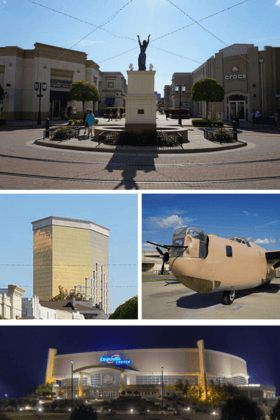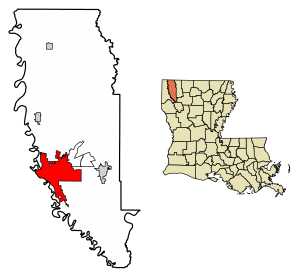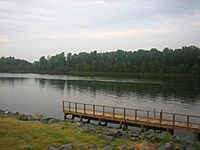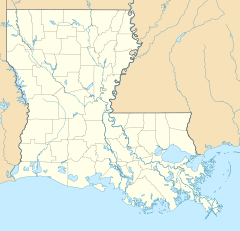Bossier City, Louisiana facts for kids
Quick facts for kids
Bossier City, Louisiana
|
||
|---|---|---|
| City of Bossier City | ||

From top, left to right: Central plaza of the Louisiana Boardwalk, the Horseshoe Hotel and Casino, B-24J Liberator at Barksdale Air Force Base, CenturyLink Center
|
||
|
||
| Motto(s):
"Union, Justice, Confidence"
|
||

Location of Bossier City in Bossier Parish, Louisiana
|
||
| Country | United States | |
| State | Louisiana | |
| Parishes | Bossier | |
| Founded | 1907 | |
| Area | ||
| • City | 45.02 sq mi (116.60 km2) | |
| • Land | 43.85 sq mi (113.57 km2) | |
| • Water | 1.17 sq mi (3.03 km2) 1.89% | |
| • Metro | 2,698 sq mi (6,987.8 km2) | |
| Elevation | 174 ft (53 m) | |
| Population
(2020)
|
||
| • City | 62,701 | |
| • Rank | BO: 1st LA: 7th |
|
| • Density | 1,429.90/sq mi (552.08/km2) | |
| • Metro | 393,406 (US: 140th) | |
| Time zone | UTC−6 (CST) | |
| • Summer (DST) | UTC−5 (CDT) | |
| Area code(s) | 318 | |
| FIPS code | 22-08920 | |
| Primary airport | Shreveport Regional Airport | |
| Interstates | ||
| Website | BossierCity.org | |
Bossier City ( BOH-zhər) is a city in Bossier Parish in the northwestern region of the U.S. state of Louisiana in the United States. It is the second most populous city in the Shreveport–Bossier City metropolitan statistical area. In 2020 it had a total population of 62,701 up from 61,315 in 2010. It is on the eastern bank of the Red River and closely tied economically and socially to its larger sister city Shreveport on the opposite bank. Bossier City is the largest city in Louisiana that is not the parish seat.
Contents
History
19th century
In the 1830s, Bossier City was the plantation Elysian Grove, purchased by James Cane and his 2nd wife Mary D. C. Cane. James and his first wife, Rebecca Bennett, came to the area with Rebecca's brother, William Bennett and his wife Mary Doal Cilley Bennett. They first had the trading post across the river on what was then Caddo Indian Land, a portion called "Bennett's Bluff". The trading post partners and Mary D. C. Bennett's father, Samuel Bennett, became a 1/7 partner in the new Shreve Town, which eventually became Shreveport.
Elysian Grove plantation was on the Red River, at the intersection of the Texas Trail on the Red River where the trading post ran the ferry crossing between what was to become Shreveport and Bossier. The plantation loading and unloading dock later became known as Cane's Landing in the old ferry log books. For a very short time, Cane's Landing was known as Cane City. Mary D. C. Bennett Cane and her family were one of the earliest settlers in the area, and Mary gave birth to the first white baby of the area, a son, William Smith Bennett Jr., who died at an early age.
In 1843, a section of land was divided out of the Great Natchitoches district and Claiborne Parish areas and was called Bossier Parish. The section of land was named in honor of Pierre Evariste John Baptiste Bossier, a former Creole general, who became a cotton farmer in Bossier Parish. He is considered one of the first settlers in the area.
In the 1840s, the Great Western Migration began, and the parish grew in population. Many early settlers passed through the region on their way to the wild West. By 1850, over 200 wagons a week passed through Bossier City. Some of these settlers stayed, attracted by the soil and river valley. In 1850, the census listed the population at around 6,962.
Civil War
During the Civil War, companies of Confederate soldiers left Cane's Landing aboard steamboats for the distant battlefields. Mrs. Cane hosted hundreds of Confederate officers and troops who were heading off to war. Mrs. Cane's plantation was fortified to protect Shreveport by three batteries, with Fort Kirby Smith in the center. The others were Batteries Price, and Walker & Ewell.
Fort Smith stood near the now Bossier High School, and protected the area from an eastern invasion. The Civil War hit Bossier Parish in 1861, and ended in Shreveport four years later when the Trans-Mississippi Department surrendered.
Shed Road
Shed Road, the first all-weather turnpike in the American South, was constructed in the 1870s and operated from 1874 to 1886. It extended for 9 miles (14 km) from Red Chute to the Red River. There was a plantation at the end of the elevated and covered roadway, which was reached by a ferry boat. The covered road made the transportation of goods easier before the arrival of the railroads.
Classification as a city
Anna B., granddaughter of James and Mary, felt the area would prosper and began promoting the idea of a riverfront city. Anna B. and J. J. Stockwell sold lots in 1883. The area grew quickly, as did transportation through it.
Cane City was said as being incorporated by former Governor Newton C. Blanchard and renamed as the village of Bossier City. Blanchard named a Shreveport businessman, Ewald Max Hoyer, as the first Bossier City mayor. Hoyer continued to reside in what is known as the Bliss-Hoyer House in Shreveport's Highland neighborhood. Bossier City has grown from an area of one square mile to a city containing more than 40 square miles (100 km2). Continued growth led to Bossier City's classification being changed from village to town by Governor John M. Parker. Later, Governor Earl Kemp Long issued a proclamation classifying Bossier City a city.
The "golden spike" commemorated the completion of the east-west Vicksburg, Shreveport and Pacific Railroad. It was driven at Bossier City on July 12, 1884, by Julia "Pansy" Rule. It was the first such spike to be driven by a woman. The north-south Shreveport and Arkansas Railroad was completed on April 6, 1888. The Louisiana-Arkansas Railroad was completed on November 2, 1909. The Dixie Overland Highway from the East to the West Coast was built in 1918. These railroads and highways combined to make Bossier City a hub for future activity.
The discovery of crude oil, to the south, in 1908, thrust Bossier City into the nationwide oil boom. Bossier's central location to the rural oil fields made it a major player in the oil patch. Several international oil companies are located here. The advantages brought by black gold fueled many civic, social and economic improvements.
A fire on June 23, 1925, consumed one-half of downtown Bossier City. Local citizens were unable to battle the blaze. The loss spurred civic improvements including a modern water system capable of fighting such fires, a new City Hall, a modern fire alarm system, modern sidewalks and the first city park.
In the 1930s, construction began on Barksdale Air Force Base. The first unit assigned to Barksdale was the 20th Pursuit Group. Before World War II, Barksdale was a training school for the Army Air Corps. During the war, Barksdale trained pilots, navigators, and bombardiers. Later the base became one of the key bases of the Strategic Air Command in the new Air Force. Barksdale is the headquarters for the 8th Air Force. The land that base is built was purchased by local residents who donated the land to the U.S. Army.
In the 1890s, Cane City had a population of about 600. Bossier City now has a 2012 estimated population of over 64,000. First a cotton-exporting river landing, next a railroad town, then an airbase and oil-boom town, Bossier City is now known for its tourism and casino gambling.
Three casinos in the city have financed a number of municipal projects, many completed during the administration of the late Mayor George Dement. Recent improvements include the CenturyLink Center, Louisiana Boardwalk, Benton Road Overpass, and the Arthur Ray Teague Parkway, located along the eastern side of the Red River. Dement also procured Amtrak service between Bossier City and Dallas, Texas. Dement was succeeded as mayor in 2005 by his administrative assistant and former mayoral opponent from 1989, Lo Walker, the first Republican to hold the city's top executive position.
Geography
Bossier City is located at 32°31′4″N 93°41′29″W / 32.51778°N 93.69139°W (32.517651, -93.691397) and has an elevation of 174 feet (53.0 m). The city lies primarily on the banks of the Red River, and has a largely flat topography. The northern city limits are noticeably more hilly than the rest of the city. Many small waterways flow through the city such as Flat River and Red Chute Bayou, which provide drainage for many areas of the city.
According to the United States Census Bureau, the city has a total area of 43.2 square miles (111.8 km2), of which 42.4 square miles (109.7 km2) is land and 0.81 square miles (2.1 km2), or 1.89%, is water.
Climate
Bossier shares most aspects of its climate with its sister city of Shreveport. The city has a humid subtropical climate (Köppen climate classification Cfa) with hot, humid summers and mild winters. During the warmer months, the city is prone to severe thunderstorms which feature heavy rain, high winds, hail, and occasional tornadoes. The city has a slightly above average rate of tornadoes when compared to the US average. Due to the flat topography of the city and the prominence of smaller waterways that are prone to backwater flooding from the Red River, the city occasionally experiences severe flooding events. A notable occurrence of severe flooding occurred in March 2016 after torrential rains caused a rapid rise of many local waterways, displacing upwards of 3500 people from their homes across the area. Freezing and ice storms occasionally occur during the winter months.
Demographics
| Historical population | |||
|---|---|---|---|
| Census | Pop. | %± | |
| 1890 | 202 | — | |
| 1910 | 775 | — | |
| 1920 | 1,094 | 41.2% | |
| 1930 | 4,003 | 265.9% | |
| 1940 | 5,786 | 44.5% | |
| 1950 | 15,470 | 167.4% | |
| 1960 | 32,776 | 111.9% | |
| 1970 | 43,769 | 33.5% | |
| 1980 | 50,817 | 16.1% | |
| 1990 | 52,721 | 3.7% | |
| 2000 | 56,461 | 7.1% | |
| 2010 | 61,315 | 8.6% | |
| 2020 | 62,701 | 2.3% | |
| U.S. Decennial Census 2018 Estimate |
|||
2020 census
| Race | Number | Percentage |
|---|---|---|
| White (non-Hispanic) | 31,843 | 50.79% |
| Black or African American (non-Hispanic) | 19,092 | 30.45% |
| Native American | 240 | 0.38% |
| Asian | 1,482 | 2.36% |
| Pacific Islander | 76 | 0.12% |
| Other/Mixed | 3,273 | 5.22% |
| Hispanic or Latino | 6,695 | 10.68% |
As of the 2020 United States census, there were 62,701 people, 26,677 households, and 17,524 families residing in the city.
2019 ACS
According to 2019 census estimates, 24.2% of the population were aged 18 and older, and 13.8% were aged 65 and older; there were 26,927 households from 2015 to 2019, with an average of 2.44 people per household.
In 2019, the racial and ethnic makeup of the city was 58.5% non-Hispanic or Latino white, 27.9% Black or African American, 0.4% Native American, 2.4% Asian, 0.1% Native Hawaiian and other Pacific Islander, 2.5% two or more races, and 8.6% Hispanic and Latin American of any race.
Of the 26,927 households, the owner-occupied housing rate was 52.8% and the median value of an owner-occupied housing unit was $163,500. The median cost with a mortgage was $1,182 versus $363 without a mortgage, and the median gross rent was $955. The median income for a household in the city was $50,340, and the per capita income was $26,755. An estimated 19.7% of the population lived at or below the poverty line.
Religion
The majority of Bossier City's population is Christian. Shreveport is more religiously diverse than Bossier. 37.9% of the local population are Baptists, primary affiliated with the Southern Baptist Convention and National Baptist Convention, USA, Inc. 6.7% are Methodists primarily served by the United Methodist Church, 5.2% are Catholics in the Shreveport Diocese, 2.2% are Pentecostal, 0.9% are Latter-day Saints, 0.4% are Presbyterian, 0.4% are Lutheran, and 0.2% are Episcopalian or Anglican. 7.7% are from another Christian group. 0.3% of the city's residents are adherents to Islam. Less than 0.1% of Bossier's residents identify with Judaism or eastern religions such as Hinduism or Buddhism.
Military
Bossier City is the location of Barksdale Air Force Base, home of the 2nd Bomb Wing, 8th Air Force, and 307th Bomb Wing. It was established February 2, 1933, and is one of the area's largest employers. Barksdale encompasses 22,000 acres (89 km2) and hosts the majority of the B-52 Stratofortresses used by the United States Air Force.
Sports and entertainment


From the 1930s to the 1970s, Bossier was regionally and even nationally known for its entertainment district known as The Bossier Strip, which followed U.S. Highway 80 through the city. Nightclubs proliferated from the Texas Avenue Bridge to the Bossier-Webster parish line. Prior to the 1940s, The Strip was as well known for such entertainment as Las Vegas, Nevada.
Bossier City and Shreveport share an all-women's flat track roller derby team named the Twin City Knockers. The team is the newest competing sport in the area, founded in January 2010. Bouts are hosted at Hot Wheels skating rink in south Bossier.
The Brookshires Grocery Arena (formerly CenturyTel Center) in Bossier City was the home of the Bossier–Shreveport Battle Wings of the AF2, as well as the Bossier-Shreveport Mudbugs of the Central Hockey League. The arena has hosted top performers, including Britney Spears and Aerosmith, as well as rodeos, ice shows, and children's entertainment.
The 2005 Red River Classic PRCA Rodeo to be hosted at the CenturyTel Center was cancelled due to the arena's use as a shelter for Hurricane Katrina evacuees.
The city hosts three riverboat casino gambling resorts along the east bank of the Red River: Margaritaville, Horseshoe, and Boomtown. Diamond Jacks previously operated in the area before closing. Horse racing and gambling on slot machines is also available at Louisiana Downs, which opened in 1974.
Education
Bossier City residents are zoned to Bossier Parish Schools. Public schools in the area are listed below:
Elementary schools
- Apollo Elementary School
- Bellaire Elementary School
- Benton Elementary School
- Bossier Elementary School
- Carrie Martin Elementary School
- Central Park Elementary School
- Curtis Elementary School
- Elm Grove Elementary School
- Kingston Elementary School
- Legacy Elementary School
- Meadowview Elementary School
- Plantation Park Elementary School
- Platt Elementary School
- Princeton Elementary School
- T. L. Rhodes Elementary School
- R.V. Kerr Elementary School
- Stockwell Place Elementary School
- Sun City Elementary School
- W.T. Lewis Elementary School
- Waller Elementary School
Middle schools
- Benton Intermediate School
- Benton Middle School
- Cope Middle School
- Elm Grove Middle School
- Greenacres Middle School
- Haughton Middle School
- Plain Dealing Middle/High School
- T.O. Rusheon Middle School
High schools
- Airline High School
- Benton High School
- Bossier High School
- Haughton High School
- Parkway High School
- Plain Dealing High/Middle School
Community colleges
- Bossier Parish Community College
Universities
- Louisiana Tech University at Shreveport-Bossier City
Notable people
- Robert E. "Bob" Barton, former member of the Louisiana House of Representatives (1996–2000)
- Sherry Boucher, former Hollywood actress and realtor in Bossier Parish
- Jimmy Boyd, state representative for Bossier Parish from 1944 to 1952
- Henry Newton Brown Jr., judge of the Louisiana Second Circuit Court of Appeals (1992–2012) and district attorney of Bossier and Webster parishes (1976–1991), is a long-term resident of Bossier City.
- Jeff Cox, judge of Division C of the 26th Judicial District in Bossier and Webster parishes since 2005
- Raymond Crews, Republican state representative for District 8
- Tim Dement, amateur boxer who competed in the 1972 Summer Olympics, former Bossier City police detective, and son of former Mayor George Dement
- Ryan Gatti, state senator for District 36, 2016-2020; Bossier City lawyer
- Eurlyne Howell, Miss Louisiana USA 1958, Miss USA 1958
- Mike Johnson, Republican U.S. Representative since 2017 for Louisiana's 4th congressional district; former state representative
- Donald Edward Jones, businessman who served as mayor of Bossier City from 1984 to 1989
- Keith Lehr, two-time World Series of Poker bracelet winner, born and resides in Bossier City
- Jared Leto, actor and musician, was born in Bossier City on December 26, 1971.
- Shannon Leto, drummer of 30 Seconds to Mars and older brother of Jared Leto, was born in Bossier City on March 9, 1970.
- Fred L. Lowery (born 1943), pastor of First Baptist Church of Bossier City, 1983–2013; Christian author
- Judi Ann Mason, born and reared in Shreveport-Bossier, Hollywood screenwriter and producer, wrote "Sister Act 2: Back in the Habit"
- John McConathy (1930–2016), professional basketball player, former superintendent for the Bossier Parish School Board
- Mike McConathy (born 1955), basketball coach at Northwestern State University in Natchitoches since 1999; former basketball coach at Bossier Parish Community College; son of John McConathy
- Alex Pourteau, professional wrestler who worked for both WWE and WCW, was born in Bossier City in 1969.
- Buddy Roemer, former United States Representative from Louisiana's 4th Congressional District (1980–87) and Governor of Louisiana (1988–92)
- Charles E. Roemer II, farmer, businessman, and politician
- B. J. Ryan was a closer in Major League Baseball for the Toronto Blue Jays of the American League. Previously, Ryan played for the Cincinnati Reds (1999) and Baltimore Orioles (1999–2005).
- Jeffrey D. Sadow, political scientist, columnist, professor at Louisiana State University in Shreveport
- Jeff R. Thompson, state representative; successor to Jane Smith
- David Toms, a professional golfer, graduated from Airline High School.
- Randy Walker, a professional American football player who played for the Green Bay Packers in 1974, graduated from Bossier High School and later Northwestern State University. Walker still holds many punting/kicking records at both schools.
- Todd Walker, a professional baseball player, graduated from Airline High School.
- Jesse Winchester, musician and songwriter, was born May 17, 1944 at Barksdale Air Force Base.
Images for kids
See also
 In Spanish: Bossier City para niños
In Spanish: Bossier City para niños






